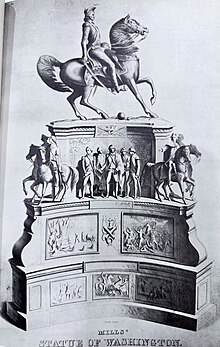Equestrian statue of George Washington (Washington Circle)
The idea of honoring George Washington, the first U.S. president, one of the Founding Fathers, and military leader of the American Revolutionary War, was first authorized by the Congress of the Confederation in 1783.The event was delayed due to weather, but a half-mile long (0.8 km) procession marched from the District of Columbia City Hall to the statue.Although he did not attend a well-known school or university, Washington received education at the Lower Church in Hartfield, Virginia.He was appointed Commander-in-Chief of the Continental Army and played a major role in winning the American Revolutionary War.According to historian and educator E. Wayne Craven, "What [Mills] learned he acquired from the life-mask itself, and this established his style as one strongly dependent upon naturalism.[9] Future President James Buchanan led the cause for a statue to be erected, referencing the earlier resolution made by the House of Representatives in 1799.[9] It is unknown why the location of the statue was chosen, but the circle, nicknamed "Round Tops" at the time, was improved in 1855 by adding wooden fences.Plans included a three-tiered base with bas-reliefs panels and small equestrian statues of Washington's generals from the war.[12] The statue and pedestal were finished by the end of 1859, and plans were made for the unveiling and dedication ceremony of the city's second outdoor monument at that time."[14] According to historian Constance McLaughlin Green, the ceremony was the "last great public nonpartisan demonstration in the ante-bellum capital" as the Civil War began the following year.[11] Researcher Jason Bezis said "It came at a moment of great tension as John Brown's failed raid on Harper's Ferry occurred just a few months earlier.Senator James H. Hammond of South Carolina introduced U.S. Representative Thomas S. Bocock of Virginia, who would become the Speaker of the Confederate States Congress the following year, to give the keynote address.[8][14] His remarks included the location of the statue was an "appropriate spot where the summer sunbeams latest linger, and where the breezes from the blue hills of [Washington's] own native and beloved Virginia delight to play.Should it ever become a ruin by a dissolution of the Union, it will...teach the lesson to all the dwellers upon earth that our grand political experiment has failed, and that man is incapable of self-government..."[8] Buchanan wore Washington's Masonic apron and used his gavel to officially dedicated the statue.Some improvements were made to the circle, including an iron fence replacing the wooden one in 1869, and in the 1880s, the hiring of a watchman to monitor and maintain the park.[12][17] Washington is depicted sitting erect and wearing his military uniform as Commander in Chief of the Continental Army.


George Washington (disambiguation)U.S. Historic districtContributing propertyD.C. Inventory of Historic SitesWashington CircleWashington, D.C.Clark MillsAmerican Revolution StatuaryL'Enfant PlanGeorge WashingtonGeorge Washington Universityequestrian statue of Andrew JacksonWhite Housecity designsPierre Charles L'EnfantFoggy BottomNew Hampshire AvenuePennsylvania AvenueK Street NWFounding FathersAmerican Revolutionary WarCongress of the ConfederationJames BuchananCongressAmerican Civil WarThomas S. BocockConfederate States CongressSupreme CourtSenateDistrict of Columbia City HallLafayette SquareNational Register of Historic PlacesDistrict of Columbia Inventory of Historic SitesLower ChurchHartfield, VirginiaThirteen ColoniesVirginia RegimentFrench and Indian WarHouse of BurgessesKingdom of Great BritainContinental Armyresigning as commander-in-chiefConstitutional ConventionConstitutionPresident of the United StatesretiredMount VernonNew YorkCharleston, South Carolinahis studioplaster life-masksE. Wayne CravenJohn C. CalhounThe Ellipseequestrian statue of President Andrew JacksonAbraham LincolnHouse of RepresentativesAndrew JacksonU.S. CongressAct of CongressWashington Monumentbas-reliefsAlexandria Gazette and Virginia AdvertiserCivil WarHarper's WeeklyJohn C. BreckinridgeWilliam PenningtonJames H. HammondSouth CarolinaVirginiaNational Park ServiceMasonicstatue of the Comte de Rochambeaustatue of Friedrich Wilhelm von SteubenRoman Bronze WorksWarren G. HardingDemocratRepublicanK StreetRevolutionary War statuesIsrael–Hamas warGeorge Washington University HospitalSchneider TriangleJean-Antoine HoudonBattle of PrincetonFort LeavenworthfounderList of sculptures of presidents of the United StatesList of statues of George WashingtonList of public art in Washington, D.C., Ward 2National Register of Historic Places in Washington, D.C.Outdoor sculpture in Washington, D.C.Senior Officer of the ArmyDelegateSecond Continental CongressFirst Continental CongressMilitary careerRevolutionary WarJumonville GlenBattle of Fort NecessityBattle of the MonongahelaForbes ExpeditionWashington in the American RevolutionCommander-in-chief, Continental ArmyAides-de-campWashington's headquartersoffice and sleeping tentBoston campaignSiege of BostonNew York and New Jersey campaignDelaware River crossingBattle of TrentonBattle of the Assunpink CreekPhiladelphia campaignBattle of BrandywineBattle of GermantownBattle of White MarshValley ForgeBattle of MonmouthBattles of SaratogaSullivan ExpeditionYorktown campaignSiege of YorktownCulper Spy RingNewburgh ConspiracyNewburgh letter